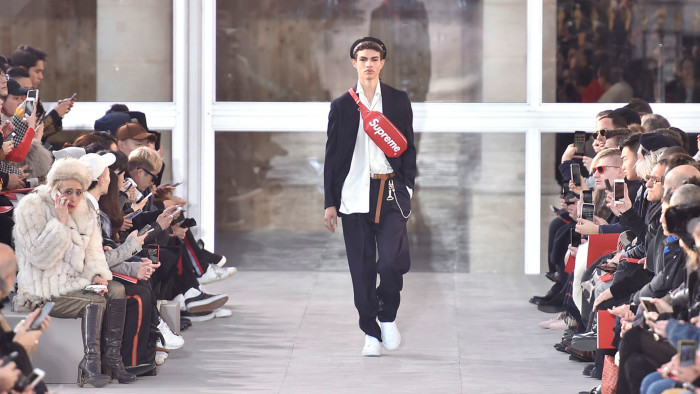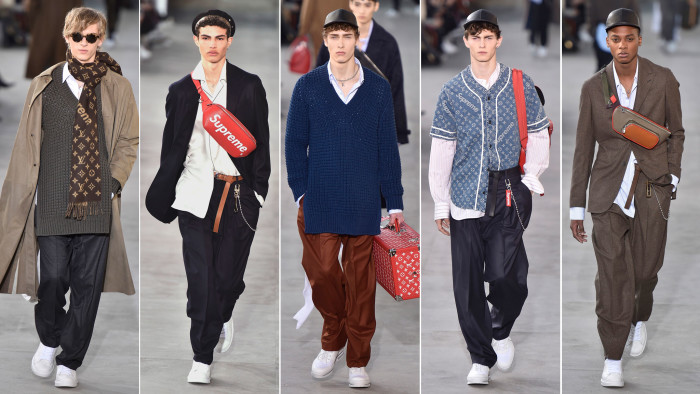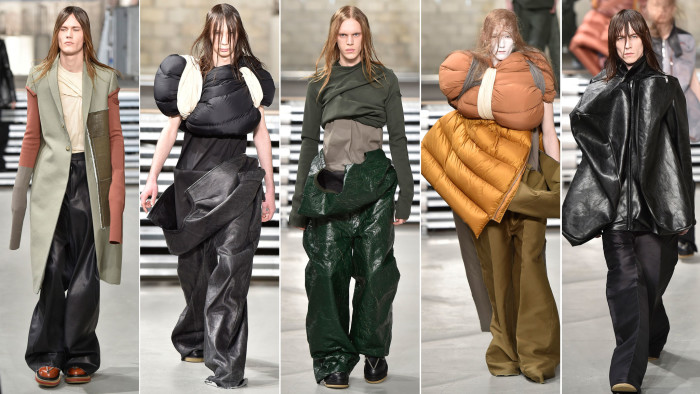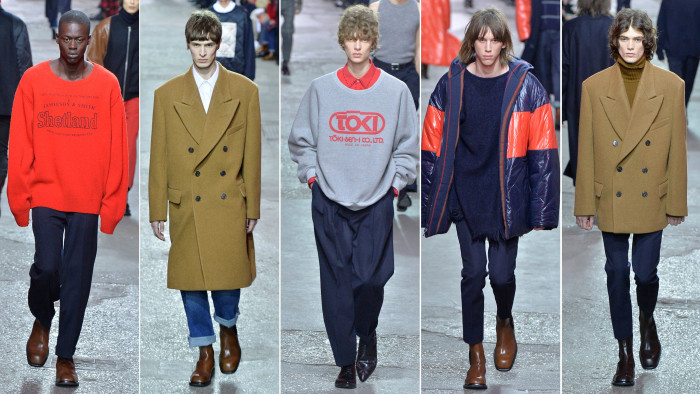Louis Vuitton meets Supreme: the ultimate cult brand collaboration?

Simply sign up to the Life & Arts myFT Digest -- delivered directly to your inbox.
“I mean, there’ll be riots,” said Kim Jones, the men’s artistic director of Louis Vuitton. It was the day before his autumn/winter 2017 show, and he was showing me the much-rumoured Louis Vuitton collaboration with New York skateboard label Supreme. Don’t know the power of the brand? Head to Soho, in either New York or London, on the Thursday mornings when new Supreme product arrives. Such is the devotion that Supreme attracts that queues form down the street, with expectant customers often sleeping out overnight. This perfect storm of Louis Vuitton with Supreme has been the subject of fervent online speculation since an image leaked last month. Now a reality, it will cause retail mayhem.
This Louis Vuitton collection was clever on many levels, not least for the brokering of such an elite partnership. The show also had an identity separate from the Supreme product. Indeed, when the Supreme pieces sell out in a day, as they most likely will, the remaining collection will happily be able to stand on its own.
Supreme first: the white Supreme logo was printed on red leather Louis Vuitton holdalls, bumbags and backpacks. Jones said his favourite piece was a pale blue denim jacquard baseball shirt woven with both LVs and the Supreme logo. Meanwhile the LV logo in white was printed on Supreme red for made-to-order items like a skateboard trunk. Yes, such an item exists.
The idea for the collaboration came about through a conversation between Jones and his CEO. “Michael Burke called me late one night saying, do you know the guys at Supreme, because I find them really interesting,” Jones recalled. “I said that I did, and that it would be great to do something together. We started playing around with ideas.”
Many luxury brands hanker for the Supreme business model. Founded by James Jebbia in 1994, it drip-feeds its collections into stores on Thursdays throughout the season, often not releasing imagery or information until a couple of days before. It has no press office, and only occasionally flyposts guerrilla ad campaigns around the city: posters of Morrissey in a Supreme T-shirt, say, or Kermit the Frog.

It’s prices are relatively low. “We’ve been very mindful of the Supreme customer in terms of price points,” said Jones, though he was no more specific. The product is made by Vuitton, and so will only be in around 40 of its stores worldwide. There will also be pop-ups, following the success of the current temporary spaces for Jones’s last LV collection, which included a collaboration with the Chapman Brothers (LV does not release figures, but there were big smiles inside their headquarters).
A few days before, Jones had posted a photo of an old LV campaign from 1996 on Instagram. It featured an image of Grandmaster Flash crouched on a record case, made by Helmut Lang in collaboration with the brand. The collaboration, also including an LV Bustle bag by Vivienne Westwood, happened a year before LV appointed Marc Jacobs to design the brand’s first ever fashion collection. We now think of Vuitton in terms of garments, but this Supreme collaboration spoke to a time before, when it was all about the leather product. This collection captured that cultishness, desirability, and the way that a brand can encapsulate some sense of what we want our lives to be. It was also a real fashion moment.
But let’s not forget the clothes, because they were great: fantastically wearable and often completely normal, as many of the best things are right now. A long blue chunky knit sweater was worn with a pale blue open-necked shirt and wool flannel pleat pants. A navy waxed cotton blouson was closed with firemans clasps, worn over a wide stripe shirt and grey tank top, the pants again pleated. You get the idea? Super simple gorgeous stuff.

“Bombast is my middle name,” said Rick Owens, after his bravura show about defiance in the face of turbulence. His AW17 collection came from thinking of the glitter era in the 70s, and how it’s sexual liberation and anti-conformity was a response to political oppression or threat. The resulting clothes were a display of his ability to manipulate materials with assurity and lightness. Padded nylon was wrapped and held over the shoulders — Owens called them “shrugs”. Wide leather pants had an unfastened, gaping top, like a boiler suit undone and pushed off the top half of the body. A zip-up leather jacket had extraordinary zippered lapels that puffed out into cuboid shapes. Are these words making any sense? His clothing can go beyond language.
Tailored jackets had ultra long sleeves, or were worn somehow sideways across the body like capes. The same was true for padded nylon jackets, with trains trailing on the floor behind. All this was done to the sound of Montserrat Caballé singing “Mon Couer S’Ouvre Á Ta Voix” from Samson and Delilah. “It is Delilah seducing Samson, so that she can gain his trust, cut off his hair and destroy him,” said Owens. “It’s the prettiest opera in the entire universe, I think.”
And what about those shrugs? Do they unravel, or are they secured as garments like that? “It’s like that,” he said. “You can wear them over the down coat you just bought from Balenciaga. You can put mine on top and…” He pauses. “Dominate it.”

What a great day for shows. Dries Van Noten sent out a collection of immediate desirability, often referencing his own work as he moves towards his 100th ever fashion show. The opening long double-breasted coat of roomy shoulder has appeared often before. “We showed it in 2009, 2010, 2012, 2014,” he said afterwards. “It’s not out of laziness. We started to change things, then we said, no, it’s perfect as it is.”
This was one of those banging collections where each look had believable energy. That opening coat was worn with rolled up jeans and high Chelsea boots. Double-breasted blazers were styled with rollnecks. A crumpled white patch pocket shirt worn with four-pleat wide pants is in the running for outfit of the season. Quilted nylon zip-ups in navy blue with an orange band would be perfect for right now in -2 degrees Paris.
The collection celebrated its fabric suppliers. A sweater came printed with the logo of Jamieson & Smith, suppliers of Shetland wool. A grey sweatshirt with the Toko-Seni logo presumably was made from its cloth: I’m happy to be introduced to this maker of sweatshirt cotton using historic looms. And those jeans. They had the sexlessness of jeans worn by some early 80s band whose songs you can sing but whose name you cannot remember. I mean that as the greatest compliment.
Newsflash: there’s a designer in Paris who’s actually practicing what he preaches. When most creative directors take their bow, whatever outre fashion they have designed, they do so wearing a navy crewneck and Levi’s. Backstage before his Off-White show, Virgil Abloh was wearing wide pants. In this season of catwalk width on the lower half, Abloh was the first designer to actually sport them in public.
“I’m tired of my other pants,” he said. “They’re comfortable and they’re different and I’m trying to show their wearability.” A few minutes later, the wide pants appeared on the catwalk, great in denim. Abloh said he wanted to look further than the streetwear with which his brand made its name. He wanted to look to older men, which led to tailored coats in teddy. But there were also bombers, and knits with surrealist words and image — a fine mix.
Photographs: Catwalking
Comments